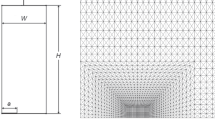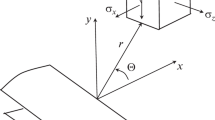Abstract
The elastic support method was recently developed to simulate the effects of unbounded solids in the finite element analysis of stresses and displacements. The method eliminates all the computational disadvantages encountered in the use of `infinite' elements or coupled finite element boundary element methods while retaining all the computational advantages of the finite element method. In this paper, the method is extended to the elasto-plastic analysis of fracture in infinite solids by using the load increment approach and including the effects of strain hardening. Numerical tests and parametric study are conducted by analysing a straight crack in an infinite plate. Present results for J integrals and plastified zones are compared, respectively, with analytical solutions and available results obtained by using the body force method. The agreement between the results is found to be very good even if the truncation boundary of the finite element model is located very close to the crack tip or the plastified zone.
Similar content being viewed by others
References
Beer, G. and Watson, J.O. (1994). Introduction to Finite and Boundary Element Methods for Engineers, Wiley, Chichester.
Chen, D.H. and Nisitani, H. (1992). Analysis of elasto-plastic problems based on the principle of superposition, part II: elasto-plastic analysis of an infinite plate with an elliptic hole or a crack. International Journal of Plasticity 8, 245–269.
Dugdale, D.S. (1960). Yielding of steel sheets containing slits. Journal of Mechanics and Physics of Solids 8, 100–104.
Hellan, K. (1984). Introduction to Fracture Mechanics, McGraw-Hill, New York.
Liu, J.B. and Sharan, S.K. (1995). Analysis of dynamic contact of cracks in viscoelastic media. Computer Methods in Applied Mechanics and Engineering 121, 187–200.
Liu, J.B., Sharan, S.K., Wang, D. and Yao, L. (1995). A dynamic contact force model for contactable cracks with static and kinetic friction. Computer Methods in Applied Mechanics and Engineering 123, 287–298.
Owen, D.R.J. and Fawkes, A.J. (1983). Engineering Fracture Mechanics: Numerical Methods and Applications, Pineridge Press, Swansea.
Owen, D.R.J. and Hinton, E. (1986). Finite Elements in Plasticity: Theory and Practice, Pineridge Press, Swansea.
Rice, J.R. (1968). Mathematical analysis in the mechanics of fracture. Fracture: an Advanced Treatise, (edited by Liebowitz, H.), Academic Press, New York.
Sedov, L.I. (1972). A Course in Continuum Mechanics, Wolters-Noordhoff, Groningen.
Sharan, S.K. (1992). Elastostatic analysis of infinite solids using finite elements. International Journal for Numerical Methods in Engineering 35, 109–120.
Sharan, S.K. (1994). Finite element analysis of infinite solids using elastic supports. Computers and Structures 53, 1145–1152.
Sharan, S.K. (1999). Viscoplastic plane-strain analysis of infinite solids using elastic supports. International Journal for Numerical Methods in Engineering 45, 355–369.
Tada, H.P., Paris, P.C. and Irwin, G.R. (1973). The Stress Analysis of Cracks Handbook, Del Research, Hellertown, Pensylvania.
Viladkar, M.N., Noorzaei, J. and Godbole, P.N. (1994). Behaviour of infinite elements in an elasto-plastic domain. Computers and Structures 51, 337–342.
Wearing, J.L. and Burstow, M.C. (1994). Elasto-plastic analysis using a coupled boundary element finite element technique. Engineering Analysis with Boundary Elements 14, 39–49.
Zienkiewicz, O.C. and Taylor, R.W. (1989). The Finite Element Method. McGraw-Hill, London.
Author information
Authors and Affiliations
Rights and permissions
About this article
Cite this article
Sharan, S.K. Elasto-plastic finite element analysis of a crack in an infinite plate. International Journal of Fracture 103, 163–176 (2000). https://doi.org/10.1023/A:1007698426810
Issue Date:
DOI: https://doi.org/10.1023/A:1007698426810




